JRR Tolkien Biography

J.R.R Tolkien was probably one of the most influential writers in the 20th century. He wrote The Lord of the Rings, one of the best books ever written (in my opinion, I read it at least ten times).
Early Life
John Ronald Reuel Tolkien was born in Bloemfontein (in South Africa, today) in 1892. He had a younger brother, Hilary Arthur Reuel Tolkien. They were taken to England in 1895 by their mother, Mabel, but Tolkien's father died in South Africa while they were there, so they decided to stay in England.
While staying at Sarehole (near Birmingham), Tolkien liked exploring the Moseley Bog and the Clent, Lickey, and Malvern Hills. He enjoyed going to his aunt's farm, Bag End, the name of which he later used in his books.
Tolkien was homeschooled by his mother. He was able to read at the age of four, and enjoyed books about Native Americans, fantasy stories by George MacDonald, and Andrew Lang's fairy stories. He disliked Treasure Island and thought that Alice's Adventures in Wonderland was "amusing but disturbing".
In 1904, Tolkien's mother died, and her sons were given to the care of Francis Xavier Morgan, a Catholic priest who was friends with JRR Tolkien's mother.
Later, Tolkien encountered a constructed language made by his cousins Mary and Marjorie Incledon. This inspired him to learn Esperanto, one of the most popular constructed languages, and later to invent the languages in his books.
In 1892, Tolkien met Edith Mary Bratt, who was three years older than him. They fell in love, but Father Francis forbade Tolkien marrying or even talking to Edith until he was 21.
In the summer of 1911, Tolkien went to Switzerland. This trip to Switzerland inspired Bilbo's journey through the Misty Mountains. His hike from Interlaken to Lauterbrunnen, where he camped on moraines, was one of the major inspirations for Bilbo's escape from the goblins.
Marriage & Army Service
In January 1913, Tolkien and Edith were formally engaged, and in 1915, Tolkien joined the army to fight in World War I. He was commissioned as a Second Lieutenant and sent to Cannock Chase, near Rugeley, to train. He was married to Edith on 22 March 1916. On the second of June, he was told in a telegram to go to Folkestone and board a troop transport to France.
He departed for France on the fifth of June, and while waiting to be called to his battalion, he became extremely bored and composed a poem called The Lonely Isle, inspired by his crossing to Calais. On the twenty-seventh of June, he left Étaples, where he was staying, and traveled to Rubempré, where he took command of his battalion, which was mostly composed of working-class men drafted from Lancashire.
"The most improper job of any man ... is bossing other men. Not one in a million is fit for it, and least of all those who seek the opportunity."
― J.R.R. Tolkien, The Letters of J.R.R. Tolkien
In early July, Tolkien arrived at the Somme, where he was eaten alive by "hordes of lice". The Medical Officer's ointment was useless, and Tolkien contracted trench fever. He was sent back to England on the eighth of November.
Post-war Work
In 1917, while he was recovering from his trench fever, Tolkien started writing The Fall of Gondolin, which was partly inspired by his experiences in the Great War. Later in 1917, he and Edith had their first son, John Francis Reuel Tolkien.
On 16 July 1919, Tolkien was given a temporary disability pension and taken off active service. His first job after WWI was at the Oxford English Dictionary, where he studied words of Germanic origin starting with the letter W.
In 1920, Tolkien became a reader (a rank below professor) at the University of Leeds. While he was there, he wrote A Middle English Vocabulary, a definitive edition of Sir Gawain and the Green Knight, and translated Sir Gawian, Pearl, and Sir Orfeo, as well as Beowulf.
In the early 1930s, Tolkien was marking School Certificate papers when he found a blank page. On it, he wrote, "In a hole in the ground there lived a hobbit." In late 1932, he had finished The Hobbit, and on 21 September 1937, it was printed for the first time. The book has never been out of print since.
Tolkien's fans bombarded him with requests to write more about hobbits, so, after The Hobbit's publication in 1937, he started writing The Lord of the Rings. In 1948, he completed the book, and published it.
Retirement
Tolkien retired in 1959, and later moved to Bournemouth, a seaside town populated by the upper middle class. Tolkien was a consultant and translator for the Jerusalem Bible, he translated the book of Jonah.
In 1971, his wife, Edith, died, and he moved back to Oxford. In 1972, he was made a Commander of the Most Excellent Order of the British Empire, and in 1973, he died and was buried next to his wife in Oxford.
I wrote about JRR Tolkien because I like his books. They are full of adventure, and feel more like a history of a fantasy world than just another adventure story.
The theme of The Lord of the Rings is the battle between good and evil and how good always wins, where good is represented by Aragorn, the Rohirrim, Frodo and Sam, the Gondorians, etc. and evil is represented by Sauron and Saruman.
Plot
The story begins in the Shire, a peaceful land populated by hobbits. Bilbo, an eccentric, rich hobbit, hosts a large birthday party for his one hundred eleventh birthday and subsequently disappears. Gandalf, a wizard who was friends with Bilbo, tells the latter's nephew and heir to keep a ring that belonged to his uncle secret and leaves. Later, he comes back and tells Frodo about how the ring is tied to an evil sorcerer named Sauron, and how it must be destroyed in the fires of Mount Doom. He tells Frodo to set out towards Rivendell, the home of the Elves.
Frodo, with his gardener\cook\bodyguard Sam, and his friends Merry and Pippin leave the Shire and travel to the Prancing Pony, an inn where they meet Aragorn, a Ranger who is secretly the heir to the throne of Gondor. He helps them get to Rivendell, but Frodo was stabbed by a Black Rider, a servant of Sauron, with a poisonous knife. Frodo survives and continues on his journey with Gandalf, Aragorn, a man named Boromir from Gondor, a dwarf named Gimli, and an elf named Legolas.
While crossing through the abandoned dwarf kingdom of Moria, Gandalf falls down a pit in a battle with a Balrog, another servant of Sauron, and later, Boromir falls in battle with Uruk-hai (creatures like orcs), Pippin and Merry get abducted by Uruk-hai, and Frodo and Sam go on their own path to Mordor, the lair of Sauron.
Aragorn, Gimli, and Legolas go through the lands of the Rohirrim to get Merry and Pippin back, but the Riders of Rohan killed the Uruk-hai and the hobbits were taken by one of Gandalf's friends through a forest named Fangorn. Then, Gandalf comes back and he, Aragorn, Gimli, and Legolas help the Rohirrim fight off the Uruk-hai at a stronghold called Helm's Deep.
Meanwhile, Merry and Pippin meet Treebeard, a humanoid tree, and they convince him to gather his kind and destroy Isengard, Saruman (an ally of Sauron)'s lair.
Frodo and Sam end up going to Mordor with a former hobbit named Gollum whom they met on the way, and who leads them through a passage in the Black Mountains into Mordor. However, he tries to kill them by leading them to Shelob, a gigantic spider, however, Sam defeats the beast and later, Frodo and Sam continue toward Mount Doom.
Aragorn and the rest relieve the city of Gondor from the attack of Sauron's forces and continue to the Black Gate, where they fight a gigantic horde of Sauron's minions.
However, Frodo and Sam get to Mount Doom, where they destroy the Ring, and Sauron dies, and his minions book it out of there. Frodo and Sam go back home. Later Frodo, Bilbo, and Gandalf go with the Elves to The Undying Lands, where more elves live, and Aragorn becomes the king of Gondor.
Works Cited:
“J. R. R. Tolkien.” Wikipedia, Wikimedia Foundation, 6 Mar. 2023, https://en.wikipedia.org/wiki/J._R._R._Tolkien.
Hammond, Wayne. “J.R.R. Tolkien.” Encyclopædia Britannica, Encyclopædia Britannica, Inc., 23 Mar. 1999, https://www.britannica.com/biography/J-R-R-Tolkien.




